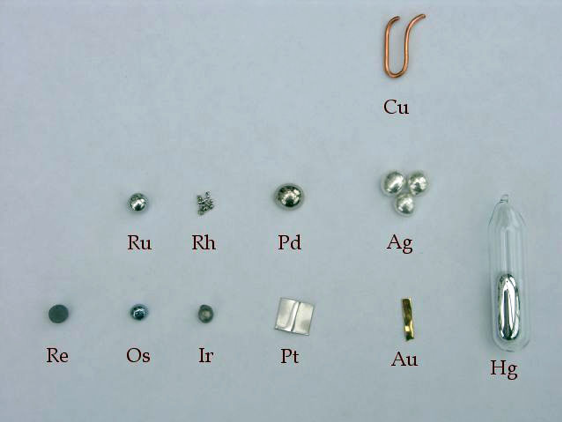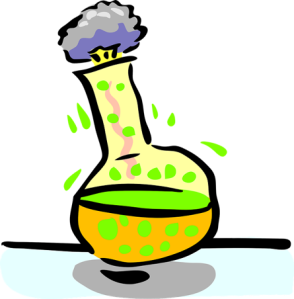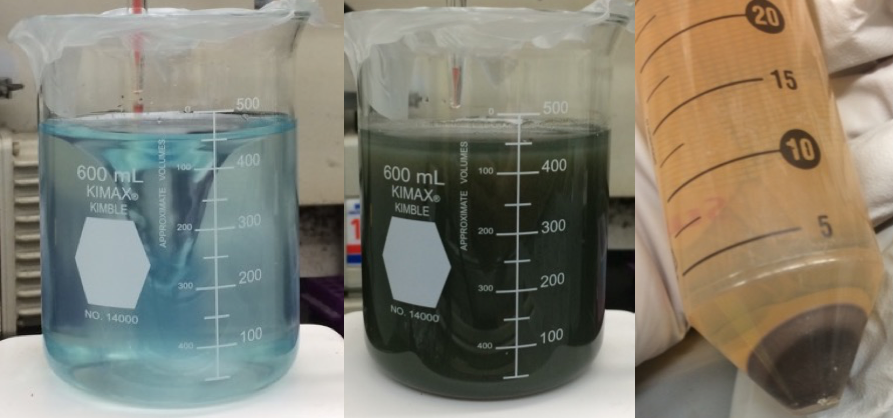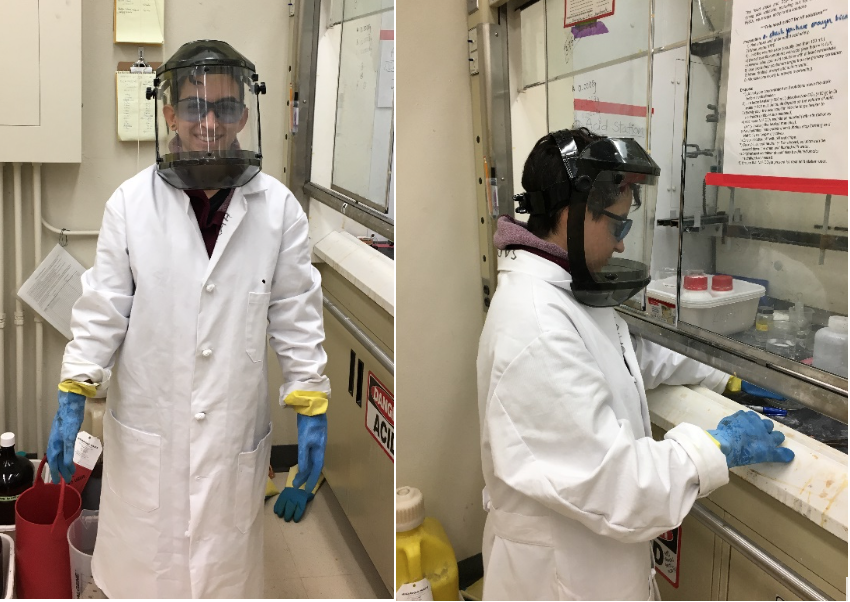Aqua regia, latin for “royal water”, is a fascinating, dangerous, and useful liquid that some of us in the Center for Sustainable Nanotechnology use on a regular basis. As I learned how to use this powerful material for my research, I started to wonder: What makes it royal? It turns out that aqua regia can dissolve many metals that are normally very challenging to dissolve, such as platinum, silver, and gold. These metals are known as noble metals, so the solution that could dissolve them was given the title “royal water.” Aqua regia is not a single chemical, but is instead a mixture of two acids, hydrochloric acid (HCl) and nitric acid (HNO3). In the case of aqua regia, the product is more powerful than the sum of its parts, which is what makes it so useful.1

But before I go into detail, let’s take a step back. What do you think of when you hear the word “acid”? Probably something like this:

Or maybe you think of a particular move in Pokémon GO that poisons your opponent!

Many of us are at least familiar with the fact that dangerous acids are corrosive; you definitely don’t want to touch them.
But what actually is an acid? An acid can be defined in many ways. One way to define it is something that increases the concentration of hydrogen ions in solution. Some acids are weak and relatively harmless, such as vinegar, which is acetic acid, or orange juice, which contains citric acid. We can drink orange juice, and use vinegar in cooking and for cleaning. Strong acids, on the other hand, can be extremely harmful if you come in contact with them. An example is sulfuric acid, which is used as an electrolyte in lead-acid batteries such as car batteries.
Aqua regia is a combination of two strong acids, hydrochloric acid (HCl) and nitric acid (HNO3), which react to form an incredibly acidic solution! When nitric acid is added to hydrochloric acid, a dark yellow/orange solution forms. Here’s a time-lapse video of the aqua regia forming its characteristic yellow/orange color after adding HCl to HNO3.
As I mentioned above, aqua regia is more powerful than the sum of its parts. It dissolves gold, even though neither constituent (hydrochloric acid nor nitric acid) can do it alone!

How Can Aqua Regia Dissolve Gold?
Many metals can either be in an elemental form or an ionic form. The elemental form, solid gold, is uncharged – chemists add a superscript “0” to the chemical symbol to show this lack of charge: for gold this would be Au0. Something called an oxidizer can cause the Au0 molecules to lose electrons, changing them into a positively charged ions, Au3+. Nitric acid is an example of a strong oxidizer, which can transform Au0 into Au3+ when they are combined. The positive gold ions then dissolve and become a part of the liquid solution. On its own, nitric acid can only dissolve a very tiny amount of the gold atoms into Au3+ before the reaction reaches equilibrium.
Once the hydrochloric and nitric acids are combined in aqua regia, the hydrochloric acid separates into H+ and Cl– ions. Because opposites ions attract, the Cl– ions are then able to react with Au3+ to form AuCl4– (also called tetrachlorogold). Because the Au3+ is now part of tetrachlorogold, it is removed from solution. That disrupts the equilibrium and allows the nitric acid to keep dissolving more Au0 into Au3+.
This is an example of Le Chatelier’s Principle, which essentially shows that if the products of a reaction are being consumed, that allows the reaction to continue forward to make more product. Think about it like a bakery; if a baker’s cupcakes are being purchased quickly, the baker will continue to make more. If they aren’t being purchased, the baker will stop making more until they need to.

Gold is just an example — aqua regia can dissolve other metals too! Since we didn’t have any gold lying around in our lab to dissolve, we decided to try using some copper. For the purpose of this blog, we put copper into the aqua regia to see what would happen, and after an hour or so it was dissolved completely!

A Nobel Example
Perhaps the most famous example of aqua regia in history occurred during the German invasion of Denmark in 1940.2 Two German Nobel laureates, Max Von Laue and James Franck, had sent their gold Nobel prizes to the lab of Neils Bohr in Denmark for protection. When the Nazis made it to Copenhagen, George de Hevesy, a Hungarian chemist working in Bohr’s lab, had to act fast to protect the medals. What do you think he did?
Yep! He dissolved them in aqua regia! The Nazi soldiers completely ignored the beakers of yellow liquid, and after World War II was over, de Hevesy found the solutions unscathed. He reprecipitated the gold and returned it to the Swedish Academy in Stockholm to be re-cast into new Nobel medals and returned to their rightful owners. So not only does aqua regia dissolve noble metals, it also dissolves Nobel medals!

Aqua Regia in the CSN
How does this all tie into the work being done in the Center for Sustainable Nanotechnology? In the CSN, we study many complex metal oxide nanomaterials. These are nanoparticles that are made of multiple different metals. One area of research in the CSN is compositional tuning – that is, intentionally changing and controlling the ratio of different metals within a single particle. One complex metal oxide material that is commonly studied in the CSN is lithium nickel manganese cobalt oxide, or NMC for short, which chemists describe as LixNi0.33Mn0.33Co0.33O2 to show the proportions of each element in the particles. (You can check out some of our earlier blog posts and podcast episodes to learn more about these materials here, here, here and here). In the “equistoichiometric” NMC, there are equal concentrations of nickel, manganese, and cobalt metals in each particle; we have also intentionally designed particles where the metals are used in different ratios.3 But after we make the nanoparticles, we need to verify ratio of metals they contain.
Our synthesis of nanomaterials is essentially just adding a bunch of precursors to a beaker, letting a solid form, and then isolating the solid particles from the liquid around them. (For more on how those nanoparticles form, check out this recent post about nucleation!) How do we confirm if the nanomaterials we have made contain the proportion of metals that we want? Just by eye, it’s impossible to tell if we’ve made what we set out to make.

That’s where aqua regia’s ability to dissolve a variety of metals comes in handy. We can use aqua regia to dissolve the complex metal oxide particles we’ve made into their constituent metal species (in the case of NMC, that’s lithium, nickel, manganese and, cobalt). We can then analyze the concentrations of each metal in solution using a technique known as Inductively Coupled Plasma – Optical Emission Spectroscopy (ICP-OES), which uses light to determine how much of each type of metal is present. Knowing the concentration of each metal in the material allows us to then calculate the ratios of each metal to see if our synthesis was a success!
The left image below shows our optically black nanoparticles before dissolution in aqua regia, and the image on the right shows the solution of the dissolved particles in aqua regia!

Safety First
As I mentioned above, aqua regia is a very dangerous substance. Because of this, we take serious precautions when using it. Here’s a picture of me preparing to make an aqua regia solution. It may not be the most fashionable look, but safety is more important!

In this picture I am wearing a labcoat to protect my skin, as well as two layers of gloves to protect my hands. I have three layers of eye protection: I’m wearing safety glasses, a face shield, and I also have the pane of glass from the fume hood in front of my face. This not only protects my eyes, but also shields my nose and mouth from the chemicals within the hood, protecting me from the inhalation hazards associated with the gaseous byproducts of making aqua regia. Whenever I use aqua regia, I’m also sure to use as small a volume as possible. When I’m done using it, I can neutralize the acidity using sodium bicarbonate – which is baking soda!
The Power of Aqua Regia
As Breaking Bad character Walter White once said, “respect the chemistry.”4 Aqua regia is a powerful tool for chemical research that has been used for centuries. When used safely, its power can be harnessed for accomplishing great things. Understanding the chemicals we work with and taking the appropriate precautions is an important part of being a responsible member of the scientific community.
EDUCATIONAL RESOURCES:
- UC San Diego: Sulfuric acid carbon snake classroom demonstration
- Chemistry in its Element Podcast: Aqua Regia
REFERENCES:
- Explanation of the chemistry of Aqua Regia: https://www.scienceabc.com/pure-sciences/aqua-regia-formula-recipe-structure-dissolve-gold-platinum.html
- Article on George de Hevesy: https://www.npr.org/sections/krulwich/2011/10/03/140815154/dissolve-my-nobel-prize-fast-a-true-story
- Ian L. Gunsolus*, Mimi N. Hang*, Natalie V. Hudson-Smith, Joseph T. Buchman, Joseph Bennett, Daniel Conroy, Sara E. Mason, Robert Hamers and Christy Haynes (* these authors contributed equally). Environmental Science: Nano, 2017, 4, 636-646. Doi: 1039/C6EN00453A
- Harnisch, F. & Salthammer, S. The Chemistry of Breaking Bad. Chemistry Views, 2013, 47, 214–221doi: 10.1002/chemv.201300114
